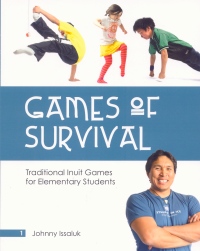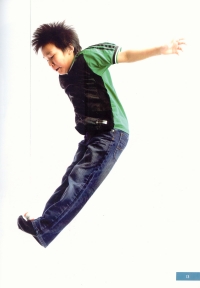| ________________
CM . . .
. Volume XIX Number 33. . . .April 26, 2013 
 |
Games of Survival: Traditional Inuit Games for Elementary Students.
Johnny Issaluk. Photos by Ed Maruyama.
Iqaluit, NU: Inhabit Media, 2012.
59 pp., pbk., $12.95.
ISBN 978-1-927095-21-8.
Subject Headings:
Inuit-Games-Juvenile literature.
Inuit-Sports-Juvenile literature.
Grades 3 and up / Ages 8 and up.
Review by Dave Jenkinson.
**1/2 /4
|
| |
|

excerpt:
There are three main categories of Inuit games: strength, endurance, and my favourite, agility. In the strength games, you face an opponent, and you challenge that person to see who is stronger. In the endurance games, you see how much you can take compared to others. In the agility games, you are competing against yourself, demonstrating how much you have practiced....It is important that Inuit games are kept alive. They were meant to keep a hunter’s mind clear and a hunter’s body strong, and now they are used to bring Inuit together, from Russia to Greenland [in the Arctic Winter Games or the Northern Games].
These competitions are where I feel closest to my ancestors. In competition, the agility games are the most challenging, requiring skill, confidence, and a lot of concentration, much like hunting for a family. Your opponents become your team and the competition becomes more like a team event. The players begin to support each other, share pointers, and coach each other – all of a sudden everyone is on the same team. Everyone is working together. (From the “Foreward” by Thomas Johnston.)
According to the publicity materials accompanying the review copy, the author of Games of Survival:
Johnny Issaluk is originally from a small Arctic hamlet on the coast of Hudson’s Bay in Nunavut called Igluligaarjuk. He presently resides in Iqaluit, Nunavut. Johnny has been successfully competing in Arctic sports since the age of sixteen. He has won countless medals over the last decade at both the regional and the national level. When Johnny is not performing Arctic sports at home and abroad, he also enjoys volunteering his time coaching and training the younger generation at the local gym.
 Issaluk begins the book by answering the question, “What Are Inuit Games?”, and in his response, he explains: Issaluk begins the book by answering the question, “What Are Inuit Games?”, and in his response, he explains:
The games came from hundreds of years ago, when Inuit lived in iglus [sic] and tents. They played the games so that they would be physically strong and mentally healthy enough to survive in the -50 degree weather in which they had to go hunting, catch caribou, and so on.
He then goes on to describe the three major types of games – agility, strength, endurance – and briefly discusses how each game category originally connected to the realities of Inuit life. For instance, in addressing strength games, Issaluk says that “the hunters didn’t need to be the strongest, but they needed to be strong enough that if they caught a walrus or a whale off the floe edge with a harpoon, they’d be able to hold the animal as long as they had to.” Issaluk concludes this two page beginning to the book by stating: “Each of these games has a purpose – we’ll learn these purposes at the same time as we learn how to play each game.”
The major part of the book is then given over to teaching readers how to perform a number of games from each of the three major game types. The agility games section contains the one foot high kick, the two foot high kick, and the Alaskan high kick. The hand pull, arm pull and head pull comprise the strength games portion of Games of Survival while the knuckle hop, airplane, back push and muskox push make up the endurance games.
Each game is accompanied by glossy, full-colour photos of Inuit children, youth or adults engaged in the game, and the text provides the instructions (sometimes via numbered steps) on how to play the game. The book’s subtitle, Traditional Inuit Games for Elementary Students, suggests that the book could also be used by classroom or physical education teachers, but, for this purpose, Games of Survival is lacking in some ways. While the photographs should clarify the steps needed to play a game, they do not always do so. For instance, in the Alaskan high kick, step one is illustrated by an adult who is holding his left foot, but step two’s photograph is of a child who is now holding his right foot. The hand pull shows a “traditional hand pull tool”, but what are people down south to use when a “traditional hand pull tool” is not available? Two additional photos connected to the same game show a man holding what appears to be the strap that later appears in the head pull. Why does it appear at all in the hand pull instructions? The written instructions do not always match what the photographs show. The back push instructions say:
Two people sit back to back with their feet flat on the floor and their knees in the air. Then they put their palms on either sides of their legs and push hard, using both their legs and their hands, into the back of the other person.
To me, putting my palms on either side of my legs should cause me to have both palms outside my body, but all three photographs show the individuals with one arm between their legs and the other arm outside the body. In many instances, the use of diagrams, in addition to the photographs, would have made the game instructions clearer to follow. Further, it is not always obvious when a game is over. Certainly, when someone can no longer hop any further on her/his knuckles, the knuckle hop is finished, but when is the head pull, the back push or the muskox push completed?
Something that teachers must always be concerned about is the risk of injury to children under their care and, in turn, their liability related to any such injuries. Again, Issaluk is not consistent in his cautions related to possible injuries. With the hand pull, he does say, “It is important to go slowly, and not to jerk, to avoid injuries.” However, in the head pull, in which a band goes around the two players’ heads, there is no mention of possible injuries to young children’s necks, and, with the airplane, where a horizontally rigid player is being supported, face down, by three other players, there is no suggestion that the playing surface be a mat in case the “airplane” is dropped.
Despite Issaluk’s assertion that readers will learn the purposes of each game as they learn how to play it, he is inconsistent in so doing. While Issaluk explains that “The hand pull was traditionally used to strengthen the wrists and the grip, so that the hunter could hold a walrus in one place until the animal got tired”, there is no such explicit explanation provided for many other games, such as the head pull or the knuckle hop. The blank pages at the book’s conclusion could have been profitably used for instructions on how to make some of the equipment required for a few of the games and/or to identify some websites where the games could be seen in action.
The appearance of the number 1 on both the book’s cover and the spine suggests that Games of Survival might be the first of a series, but no series title is provided.
In terms of its use in schools, Games of Survival offers very clear insights into how “play” in the Inuit culture was closely connected to the people’s day-to-day needs. As explained in the excerpt above, the games were less about an individual’s “winning” and more about that person’s being a contributing member of a society. In a school physical education setting, the book’s games would largely fit under the umbrella of cooperative games.
Recommended.
Dave Jenkinson, CM’s editor, lives in Winnipeg, MB.

To comment
on this title or this review, send mail to cm@umanitoba.ca.
Copyright © the Manitoba Library Association. Reproduction for personal
use is permitted only if this copyright notice is maintained. Any
other reproduction is prohibited without permission.
NEXT REVIEW |
TABLE OF CONTENTS FOR THIS ISSUE
- April 26, 2013.
AUTHORS |
TITLES |
MEDIA REVIEWS |
PROFILES |
BACK ISSUES |
SEARCH |
CMARCHIVE |
HOME |

 Issaluk begins the book by answering the question, “What Are Inuit Games?”, and in his response, he explains:
Issaluk begins the book by answering the question, “What Are Inuit Games?”, and in his response, he explains: